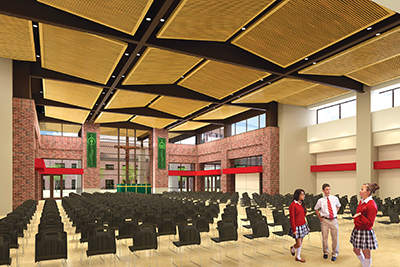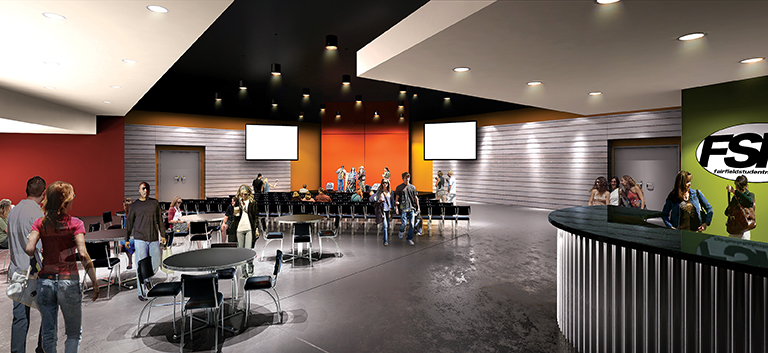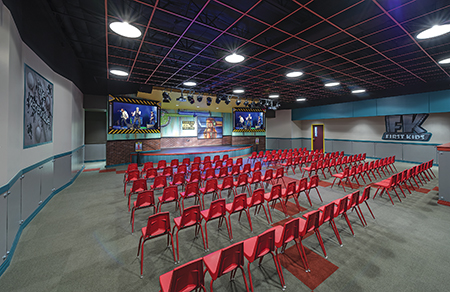
By Allison Parrott with Paul Lodholz, AIA, LEED AP
 In many churches, the youth area is often relegated to leftover space — or space the adults have outgrown and left behind. That short-sighted approach is a missed ministry opportunity.
In many churches, the youth area is often relegated to leftover space — or space the adults have outgrown and left behind. That short-sighted approach is a missed ministry opportunity.
Whether you’re planning a new space for your youth — or upgrading your existing space — some key strategies will invigorate your youth spaces while also helping your church stay within budget.
#1: Start with a plan. Youth ministers often tell us that they need a completely flexible space to do absolutely anything in their youth areas without limiting their programs. In reality, a space needs to be planned for specific functions for any of your ministry programs to work well.

This doesn’t mean the space needs to be completely inflexible; think of it more as a “priorities list.” Start with the most significant activity that will happen in the space. Doing so — and listing out the needs required — will help you prioritize needs and organize the space to accommodate them.
Once this list is in hand, you’ll begin to notice that some overlap. For example, you might need space for large-group assembly, which requires loose seating. You also need space for sitting around a table and eating pizza, which requires loose seating, too — but, the two functions never happen at the same time, so seating can be shared.
Looking at the space in terms of functional zones that can be multi-use will allow for the needed flexibility but, at the same time, will ensure you’re meeting your programs’ requirements. You can also use grid paper to draw the space to scale, or even use tape to section off the room in zones to help visualize the correct amount of space you need.

#2: Implement inexpensive fixes. Fresh paint is one of the most inexpensive ways to enliven a space. However, bolder and brighter isn’t always better!
Think about the spaces where you like to just hang out (bookstores, coffee shops, restaurants and so on). The next time you visit those places, take note of the color schemes; do they translate into your youth space? While the use of bright, energetic primary colors is appropriate in an early childhood or elementary setting, teenagers prefer something a bit more grown-up.
Writable wall surfaces and magnetic walls are another quick and easy way to perk up a room. You can grab some chalkboard paint at your local hardware store and create a prayer wall or an announcement board.
Many youth rooms are decorated with store-bought posters. These can look cheap, dated and clutter up the space very quickly. Instead, find some of your artistic youth group members and commission them to create some custom art for the space. Or, give your students an assignment to photograph the world — to showcase something meaningful about their faith. There are lots of possibilities to create unique and meaningful art that’s relevant to your ministry.
Add decorative lighting in your space with inexpensive floor lamps. These can soften the feel of the room, especially if you’re adapting an existing room that has older, 2×4 fluorescent lighting.

#3: Focus on furniture and floors. If the flooring in your space is old and worn, consider replacing it. You can rip out old carpet and check the state of the concrete slab underneath. The concrete can be ground and polished, or even stained, to create an easy-to-clean floor.
You can also purchase area rugs to help define various zones in the space and add some color. Consider using both hard and soft flooring to do this. For example, vinyl tile, polished concrete or wood-look vinyl planks can be used in entry and snack areas, while carpet can be used in assembly and lounge areas. Using different flooring materials will define the space and add interest to the room.
When furnishing the space, don’t settle for hand-me down couches! The furniture in this room should be inviting and appropriate for the types of ministry programs using the space. Furniture will be a costly upgrade, but well worth the investment.
There are many modern styles of folding chairs that can be used in your large gathering areas. For conversation areas, invest in durable leather synthetic leather or microfiber couches and lounge seating. Many new styles of seating have built-in USB charging stations, which helps when students are using iPads or other electronic devices during small group time.
The goal is to find durable furniture that’s stylish and comfortable, creating an engaging atmosphere.
And, don’t be afraid to check with your students to find out if anyone has furniture-making skills! Many high schools have “FabLabs” that teach woodwork, welding, laser-cutting and CNC routing. Students who are learning these skills might enjoy the challenge of designing and building coffee tables or other pieces for the space.

#4: Embrace technology. Today’s students are immersed in technology. School curriculums are becoming more and more interactive, and students are expected to be able to use technology in thoughtful ways.
Youth ministry should be no different.
Your space doesn’t need 90-inch plasma TVs everywhere, but small TVs — equipped with Apple TV or another wireless connection device — can enhance small group lessons.
A/V needs also need to be addressed and be appropriate for your space and ministry needs. Your students already engage with technology on a daily basis, so don’t shun it. Instead, be prepared to creatively use it while, at the same, time teaching teens how to be responsible consumers of technology in variety of ways.
Allison Parrott is the Project Manager for the Worship and Education Studio at Ziegler Cooper Architects in Houston. She is married to a church-planter and pastor and is blessed to be able to serve other churches through her professional work.
Paul Lodholz, AIA, LEED AP is the Principal-in-Charge of the Worship and Education Studio at Ziegler Cooper Architects. He has lectured around the country on the changing nature of the church lobby and has been working with churches for more than 35 years.


